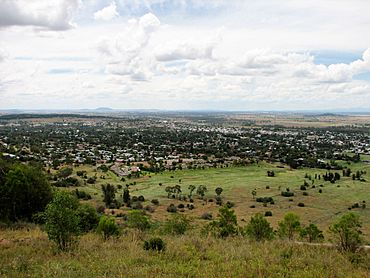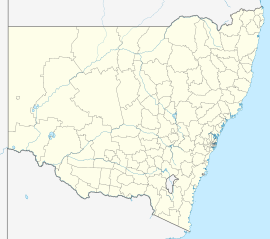Gunnedah facts for kids
Quick facts for kids GunnedahNew South Wales |
|||||||||||||||
|---|---|---|---|---|---|---|---|---|---|---|---|---|---|---|---|

Gunnedah viewed from Mount Porcupine
|
|||||||||||||||
| Population | 8,338 (2021 census) | ||||||||||||||
| Established | 1856 | ||||||||||||||
| Postcode(s) | 2380 | ||||||||||||||
| Elevation | 264 m (866 ft) | ||||||||||||||
| Location |
|
||||||||||||||
| LGA(s) | Gunnedah Shire | ||||||||||||||
| Region | North West Slopes | ||||||||||||||
| County | Pottinger | ||||||||||||||
| State electorate(s) | Tamworth | ||||||||||||||
| Federal Division(s) | Parkes | ||||||||||||||
|
|||||||||||||||
|
|||||||||||||||
Gunnedah is a town in north-central New South Wales, Australia. It is the main town of the Gunnedah Shire area. In 2021, about 8,338 people lived there.
Gunnedah is in the Liverpool Plains, a very rich farming area. About 80% of the land around the town is used for farming. The Namoi River flows through Gunnedah, providing water for farms.
The Gunnedah area grows a lot of cotton, coal, beef, lamb, and pork. Farmers also grow grains like wheat and oilseeds. Gunnedah is also home to AgQuip. This is Australia's biggest yearly agricultural field day. It is a huge event where farmers can see new machines and ideas.
Gunnedah is on the Oxley and Kamilaroi Highways. These roads connect it to many places in northern New South Wales. For example, Tamworth is about 75 km away. The town also has a train station. You can take the daily NSW TrainLink Xplorer train service to Sydney or Moree.
Gunnedah is known as the "Koala Capital of the World". However, there are worries about the health of the local koala population. Climate change and new buildings can affect their homes.
Contents
Gunnedah's History
Gunnedah and the areas around it were first home to Aboriginal Australians. They spoke the Kamilaroi (Gamilaraay) language. The name Gunnedah in Kamilaroi means "Place of White Stones".
In 1818, an English surveyor named John Oxley explored this area. There is a monument at Mullaley Mountain that remembers him. European sheep farmers settled where the town is now in 1833 or 1834. Gunnedah was first called 'The Woolshed'. It later got its name from the local Indigenous people, the Gunn-e-darr. One famous person from this group was Cumbo Gunnerah.
Coal was found on Black Jack Hill in 1877. By 1891, a lot of coal had been dug up. A company called Gunnedah Colliery Company started in 1899. They built a private railway to their mine. Later, in 1957, the government took over this railway line.
Dorothea Mackellar wrote her famous poem My Country about her family's farm near Gunnedah. This poem is also known as I Love a Sunburnt Country. To remember her, Gunnedah holds the yearly Dorothea Mackellar Poetry Awards for school students.
Important Places in Gunnedah
Gunnedah has some places that are important for their history. These are called heritage-listed sites. They include:
- The railway line from Werris Creek to Moree, including Gunnedah railway station
- Gunnedah Leather Processors
Who Lives in Gunnedah?
The 2016 census showed that 9,726 people lived in Gunnedah.
- About 13.7% of the people were Aboriginal and Torres Strait Islander.
- Most people (86.2%) were born in Australia.
- Almost everyone (90.2%) spoke only English at home.
- The most common religions were Anglican (28.8%), Catholic (27.3%), and No Religion (20.3%).
Sports in Gunnedah
The most popular sport in Gunnedah is Rugby league. The local team is called the Gunnedah Bulldogs. They play at Kitchener Park. They have won seven championships in the Group 4 Rugby League competition.
Other sports teams in Gunnedah include:
- Gunnedah AFL Bulldogs (playing in AFL North West NSW)
- Gunnedah Red Devils RUFC (playing in the Central Northern Rugby Union)
- Gunnedah FC (playing in the Northern Inland Football)
Gunnedah's Geography
Gunnedah Shire is about 264 meters (866 feet) above sea level. It is located on the Liverpool Plains in the Namoi River valley. The area is very flat. The tallest hills are only about 400 to 500 meters (1,300 to 1,600 feet) high.
The weather is hot in summer and mild in winter. It is generally dry. However, heavy rain in other areas can sometimes cause the Namoi River to flood. These floods can cut off roads, making it hard to get in or out of town. Gunnedah is built on a rich coal seam. It is also part of the northern New South Wales wheat belt.
The Gunnedah area is famous for its many native animals. You can find kangaroos, echidnas, and koalas here. Koalas are often seen in trees right in town. Signs from the local tourist center can help you spot them. Gunnedah is believed to have the largest koala population west of the Great Dividing Range in New South Wales.
Gunnedah's Climate
Gunnedah has a subtropical climate. This means temperatures often go above 40°C (104°F) in summer. They can also drop below 0°C (32°F) in winter. This is because the town is far inland.
The average yearly rainfall is about 632.9 mm (24.9 inches). Rain falls throughout the year. However, strong thunderstorms in summer often bring heavy rain. This boosts the total rainfall.
The hottest day ever recorded was 48.7°C (119.7°F) on January 24, 1882. The coldest high temperature was 4.4°C (39.9°F) on August 4, 1921. Snow is very rare in Gunnedah. The last time it snowed was in 1984.
| Climate data for Gunnedah Pool (1876–2011); 285 m AMSL; 30.98° S, 150.25° E | |||||||||||||
|---|---|---|---|---|---|---|---|---|---|---|---|---|---|
| Month | Jan | Feb | Mar | Apr | May | Jun | Jul | Aug | Sep | Oct | Nov | Dec | Year |
| Record high °C (°F) | 48.7 (119.7) |
44.4 (111.9) |
45.0 (113.0) |
37.2 (99.0) |
34.4 (93.9) |
30.4 (86.7) |
26.7 (80.1) |
31.7 (89.1) |
35.4 (95.7) |
40.0 (104.0) |
43.3 (109.9) |
46.1 (115.0) |
48.7 (119.7) |
| Mean daily maximum °C (°F) | 34.0 (93.2) |
32.9 (91.2) |
30.7 (87.3) |
26.4 (79.5) |
21.3 (70.3) |
17.6 (63.7) |
16.9 (62.4) |
18.9 (66.0) |
22.8 (73.0) |
26.7 (80.1) |
30.3 (86.5) |
32.9 (91.2) |
26.0 (78.7) |
| Mean daily minimum °C (°F) | 18.4 (65.1) |
18.1 (64.6) |
15.8 (60.4) |
11.4 (52.5) |
7.1 (44.8) |
4.3 (39.7) |
3.0 (37.4) |
4.2 (39.6) |
7.0 (44.6) |
10.8 (51.4) |
14.2 (57.6) |
16.8 (62.2) |
10.9 (51.7) |
| Record low °C (°F) | 2.2 (36.0) |
3.3 (37.9) |
−1.0 (30.2) |
−3.9 (25.0) |
−5.3 (22.5) |
−8.6 (16.5) |
−8.3 (17.1) |
−7.5 (18.5) |
−6.7 (19.9) |
−2.2 (28.0) |
0.6 (33.1) |
1.1 (34.0) |
−8.6 (16.5) |
| Average rainfall mm (inches) | 70.7 (2.78) |
65.4 (2.57) |
48.9 (1.93) |
36.6 (1.44) |
42.0 (1.65) |
44.0 (1.73) |
41.5 (1.63) |
40.9 (1.61) |
40.2 (1.58) |
54.2 (2.13) |
61.4 (2.42) |
69.6 (2.74) |
615.7 (24.24) |
| Average rainy days (≥ 1.0 mm) | 5.5 | 5.0 | 4.0 | 3.4 | 4.0 | 4.8 | 4.7 | 4.7 | 4.5 | 5.3 | 5.6 | 6.0 | 57.5 |
| Average afternoon relative humidity (%) | 43 | 45 | 44 | 46 | 51 | 55 | 53 | 48 | 44 | 43 | 40 | 40 | 46 |
| Source: Australian Bureau of Meteorology; Gunnedah Pool | |||||||||||||
| Climate data for Gunnedah Resource Centre (1948–2019); 307 m AMSL; 31.03° S, 150.27° E | |||||||||||||
|---|---|---|---|---|---|---|---|---|---|---|---|---|---|
| Month | Jan | Feb | Mar | Apr | May | Jun | Jul | Aug | Sep | Oct | Nov | Dec | Year |
| Record high °C (°F) | 45.9 (114.6) |
45.6 (114.1) |
41.5 (106.7) |
35.8 (96.4) |
28.8 (83.8) |
24.6 (76.3) |
24.6 (76.3) |
31.2 (88.2) |
35.0 (95.0) |
39.1 (102.4) |
43.1 (109.6) |
46.1 (115.0) |
46.1 (115.0) |
| Mean daily maximum °C (°F) | 32.2 (90.0) |
31.3 (88.3) |
29.2 (84.6) |
25.3 (77.5) |
20.4 (68.7) |
16.9 (62.4) |
16.2 (61.2) |
18.0 (64.4) |
21.6 (70.9) |
25.3 (77.5) |
28.6 (83.5) |
31.2 (88.2) |
24.7 (76.4) |
| Mean daily minimum °C (°F) | 19.0 (66.2) |
18.7 (65.7) |
16.7 (62.1) |
12.9 (55.2) |
8.7 (47.7) |
6.1 (43.0) |
4.8 (40.6) |
5.8 (42.4) |
8.6 (47.5) |
12.2 (54.0) |
15.2 (59.4) |
17.6 (63.7) |
12.2 (54.0) |
| Record low °C (°F) | 8.5 (47.3) |
8.9 (48.0) |
4.1 (39.4) |
2.4 (36.3) |
−1.2 (29.8) |
−2.9 (26.8) |
−3.6 (25.5) |
−2.6 (27.3) |
−0.3 (31.5) |
1.5 (34.7) |
3.3 (37.9) |
5.3 (41.5) |
−3.6 (25.5) |
| Average rainfall mm (inches) | 82.2 (3.24) |
69.9 (2.75) |
44.3 (1.74) |
37.8 (1.49) |
43.3 (1.70) |
40.3 (1.59) |
41.2 (1.62) |
35.3 (1.39) |
41.2 (1.62) |
57.1 (2.25) |
67.8 (2.67) |
70.7 (2.78) |
632.9 (24.92) |
| Average rainy days (≥ 1.0 mm) | 6.0 | 5.2 | 4.2 | 3.4 | 4.2 | 4.6 | 4.8 | 4.5 | 4.6 | 5.9 | 6.1 | 6.5 | 60 |
| Source: Bureau of Meteorology | |||||||||||||
Education in Gunnedah
Gunnedah has several schools for students of all ages.
- Secondary Schools:
- Gunnedah High School
- Carinya Christian School
- St Mary's College
- Primary Schools:
- Gunnedah Public School
- Gunnedah South Public School
- G.S. Kidd Memorial School
- St Xavier's Catholic School
- Carinya Christian School
There is also a campus of the New England Institute of TAFE. This is a college for vocational training.
Local Media
Gunnedah has its own local news and radio.
- Newspapers:
- Gunnedah Times
- Namoi Valley Independent (now only online)
- Radio Stations:
- 2MO (one of Australia's oldest radio stations, started in 1930)
- 2GGG
Getting Around Gunnedah
The Oxley Highway and the Kamilaroi Highway both pass through Gunnedah. These highways connect Gunnedah to other towns. The Oxley Highway goes east to Tamworth and west to Coonabarabran. The Kamilaroi Highway goes south-east to Quirindi and north-west to Boggabri.
Gunnedah Railway Station
Gunnedah railway station is on the Mungindi railway line. It is about 475 km (295 miles) from Sydney. The station opened in 1879. It has a main building, a platform, and a small area for goods. There are also tracks that go to a flour mill nearby. West of the station, there are many tracks for grain silos and coal loading.
For a short time after the railway arrived, Gunnedah was the end of the line. Then, the railway was extended to Boggabri and Narrabri South Junction in 1882. Today, a daily Xplorer train serves the station. It travels between Sydney and Moree.
Famous People from Gunnedah
Many notable people have come from Gunnedah.
- Leanne Castley – Member of the ACT Legislative Assembly
- Sara Carrigan – Olympic Gold Medallist
- Gordon Bray – Sports Commentator
- John "Dallas" Donnelly – rugby league player
- Tom Gleeson – Comedian
- Lindsay Johnston – rugby league player
- Miranda Kerr – model
- Katrina Burgoyne - Country music singer
- Michael Kilborn – cricketer and cardiologist
- Dorothea Mackellar – poet
- Sam Naismith - Australian rules footballer
- Gillian Campbell - Olympic rower
- John O'Neill – rugby league player
- Erica Packer – model and singer
- Angus Roberts – rugby union player
- Ben Smith – rugby league player
- Pat Studdy-Clift - author
- Ron Turner – rugby league player
- James Wynne – rugby league player
- Sergeant Leonard Siffleet – WWII Commando
- Harry Wilson - Rugby Union player, Queensland Reds and Wallabies.
- Greg Hickman (Horse Racing) – a top horse trainer who trained Pierata and Eleven Eleven.
Images for kids




